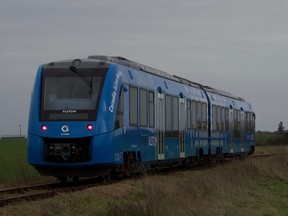$8-million pilot project will showcase the Alstom-built Coradia iLint train on the Chemin de fer Charlevoix tourist train line.

QUEBEC — In a North American first, a passenger train powered by green hydrogen will be given a dry run this summer on a tourism rail line linking Quebec City to the east.
The Quebec government will invest $3 million into an $8-million pilot project showcasing the Alstom-built Coradia iLint train. It will be put into service for three or four months this summer on the hugely popular Chemin de fer Charlevoix tourist train line, Premier François Legault announced Thursday at a news conference.
Sign up to receive daily headline news from the Montreal Gazette, a division of Postmedia Network Inc.
Thanks for signing up!
A welcome email is on its way. If you don't see it, please check your junk folder.
The next issue of Montreal Gazette Headline News will soon be in your inbox.
French-owned Alstom has been operating the train, which can carry 120 passengers, in Germany since 2018. It has now rolled in a total of eight countries racking up a total of 200,000 kilometres. On Sept. 15, 2022, it successfully travelled 1,175 km without refuelling its hydrogen tank.
This will be its North American service debut.
The Coradia iLint is described as a CO2-emission-free train that, unlike the conventional diesel locomotives, leaves only a trail of steam and condensed water in its wake.
Hydrogen is not used to directly propel the train. Instead the hydrogen is fed into a fuel cell that produces electric energy. For this experiment, the Quebec firm Harnois Énergies will produce and transport the needed hydrogen.
It is designed specifically for non-electrified trail lines and is quieter than a conventional train. The Chemin de fer Charlevoix runs a total of 148 kms, making stops in eight communities.
The Coradia iLint will arrive in Quebec from Europe by boat in the coming weeks.
For Legault, who has declared 2023 a year where he wants Quebec to focus on the electrification of Quebec, the pilot project is a live example of what he believes is the way forward as Quebec attempts to make itself carbon neutral by 2050.
“We think it is very promising and we need to be associated with this innovation, which will keep getting better,” Legault told a crowd of business people and cabinet ministers on hand in a suburban Quebec City train station for the announcement.
“We are slowly demonstrating that it is possible, and we will get there, for Quebec to become a world leader in green energy.”
On hand for the announcement was Alstom president Michael Keroullé, who noted very little of the North American rail system is served electrically. The objective of the pilot project is to prove the technology is a viable alternative to diesel and that it is possible to get a supply chain of hydrogen to run the trains.
He conceded that this particular train is not winterized and will be only in used for the summer months starting in June 2023.
“One of the main topics we will have to study is the winterization of that train,” Keroullé said.
On the other hand, with 28,000 diesel locomotives in service in North America, Alstom thinks there is growth potential with its train.
“Once the technology works, we can approach the market and start to deploy these as new emission technologies,” Keroullé said. “But it will take seven years to get to a point where can start to sell products. So starting now is really important and that’s why we wanted to bring the train as a first step.”
The announcement follows a week at the legislature where Quebec’s energy future has been front and centre.
Following the premier’s comments last week that Quebec will need four or five new dams to meet future power demands, Hydro-Québec revealed that in order to meet the needs of all future potential investment, that number would have to be much higher: about 23,000 megawatts.
Economy and Energy Minister Pierre Fitzgibbon has said that number is not realistic and has revised the number down to 10,000 megawatts of additional electricity.
But it’s clear the government is ready to dabble in many options — including green hydrogen — to reach its goals of producing more power, stimulating investment at the same time as favouring companies producing limited greenhouse gas emissions.
While green hydrogen can be part of the puzzle to reduce the greenhouse gas produced by the transportation of goods and people, it requires a lot power to make it, which means it can’t be the only option, Fitzgibbon told reporters.
“Hydrogen is kind of the backup because we cannot, right now, technologically (use it) to electrify the whole economy,” Fitzgibbon said. “We have to be selective, we have to be small.”
Legault noted that in the last election campaign, Quebec’s Liberals made green hydrogen a central part of their environmental vision.
“They said they would invest billions in the nationalization of green hydrogen,” Legault said. “We disagree with them.”
Officials, however, said later that tourists will have the option of selecting the green hydrogen train — which will be one of three options on the route this summer — so they can tell friends they rode the sleek, silent non-polluting prototype.
pauthier@postmedia.com
twitter.com/philipauthier
-

The Right Chemistry: Hydrogen power is making significant inroads
-

Power-hungry Quebec will soon need more hydro dams, Legault says
-

Opposition parties express concerns over future of Hydro-Québec


